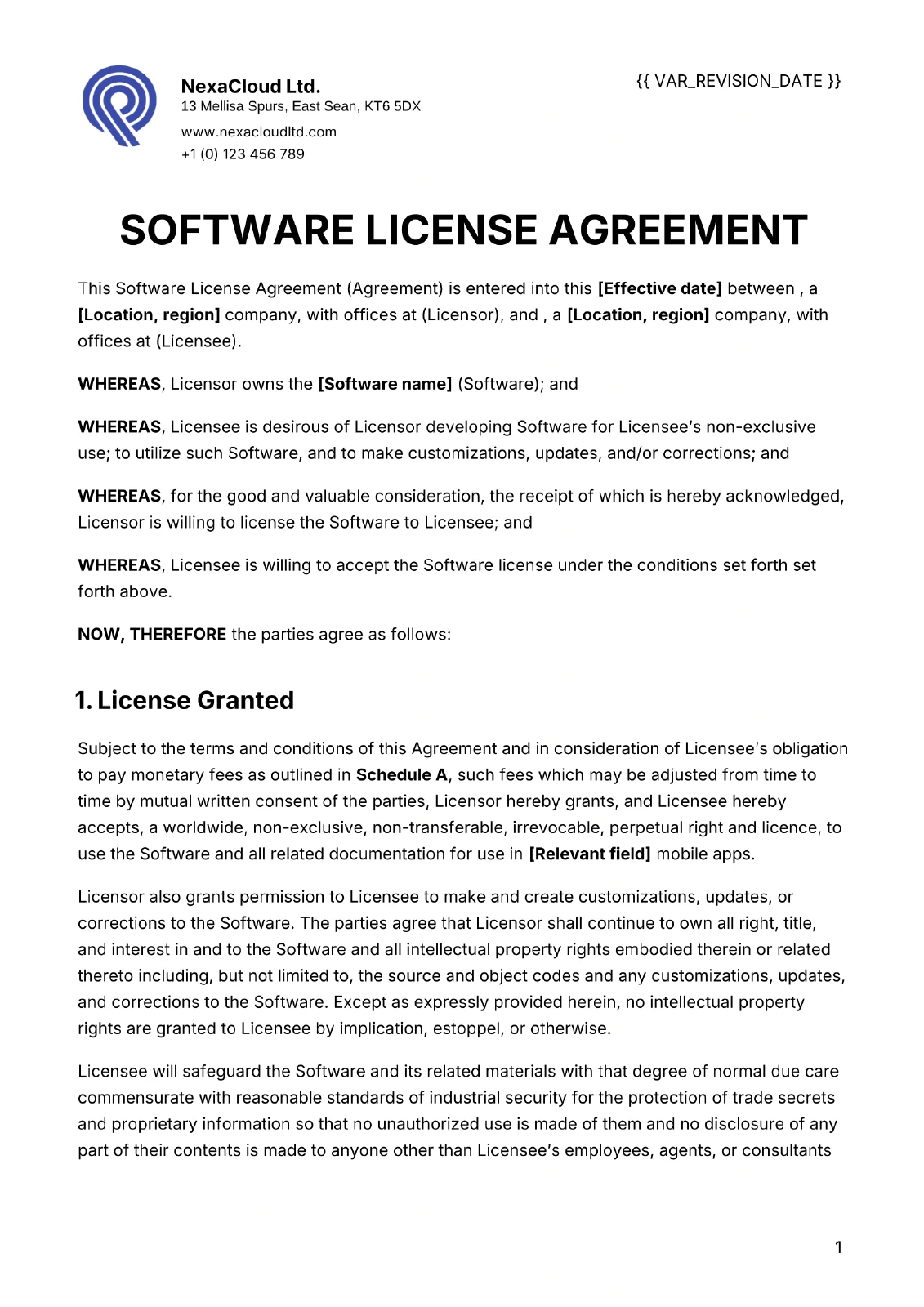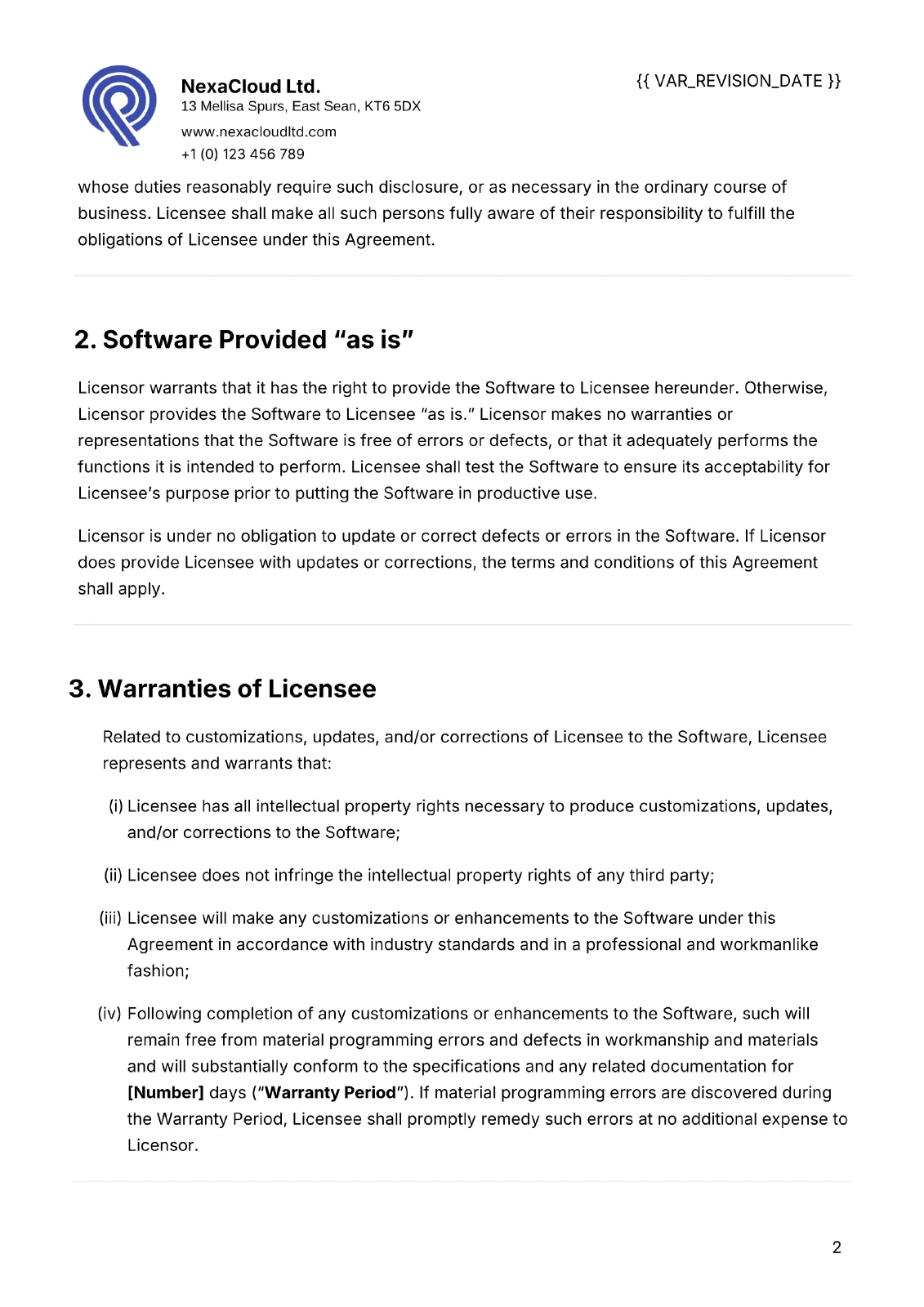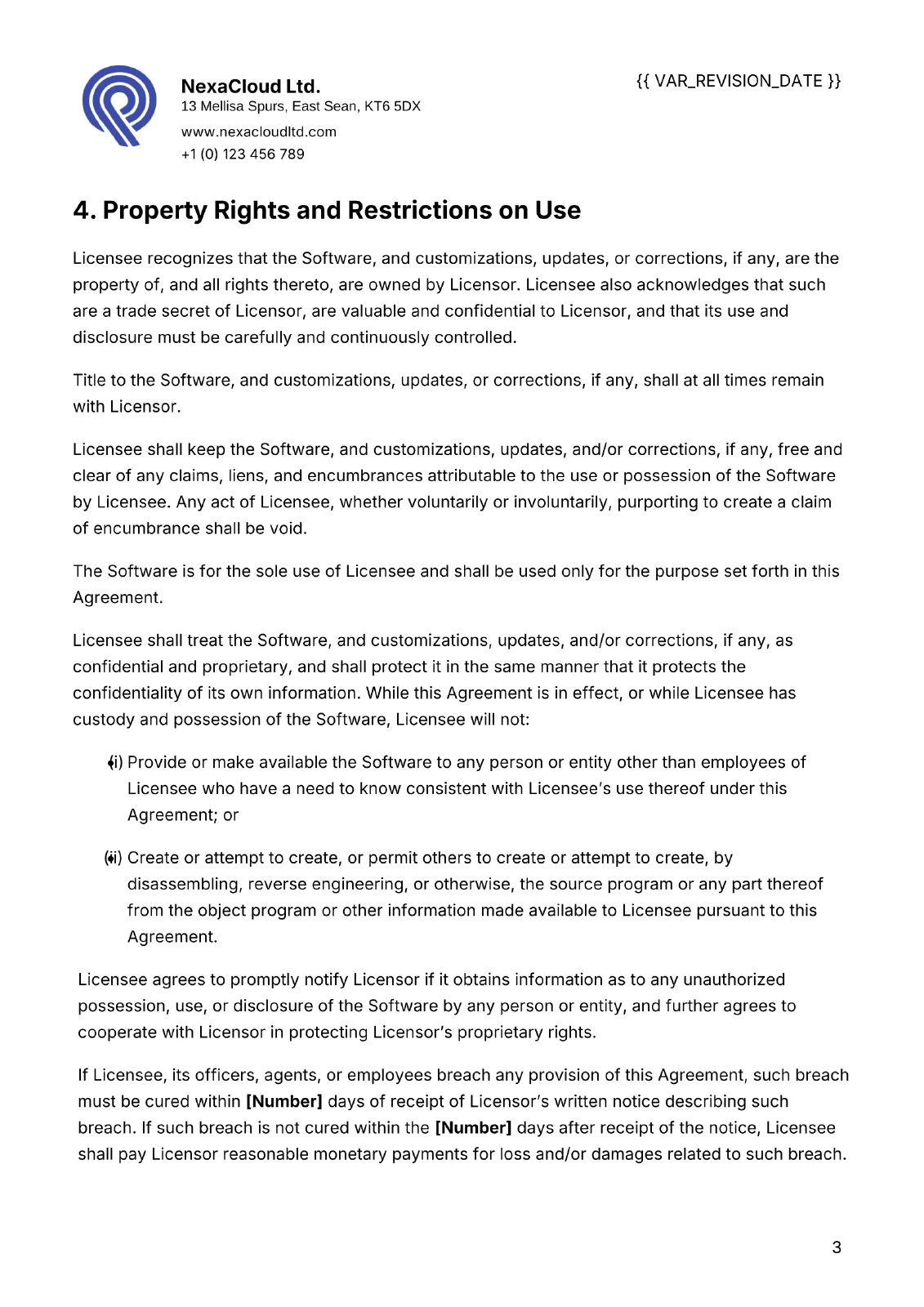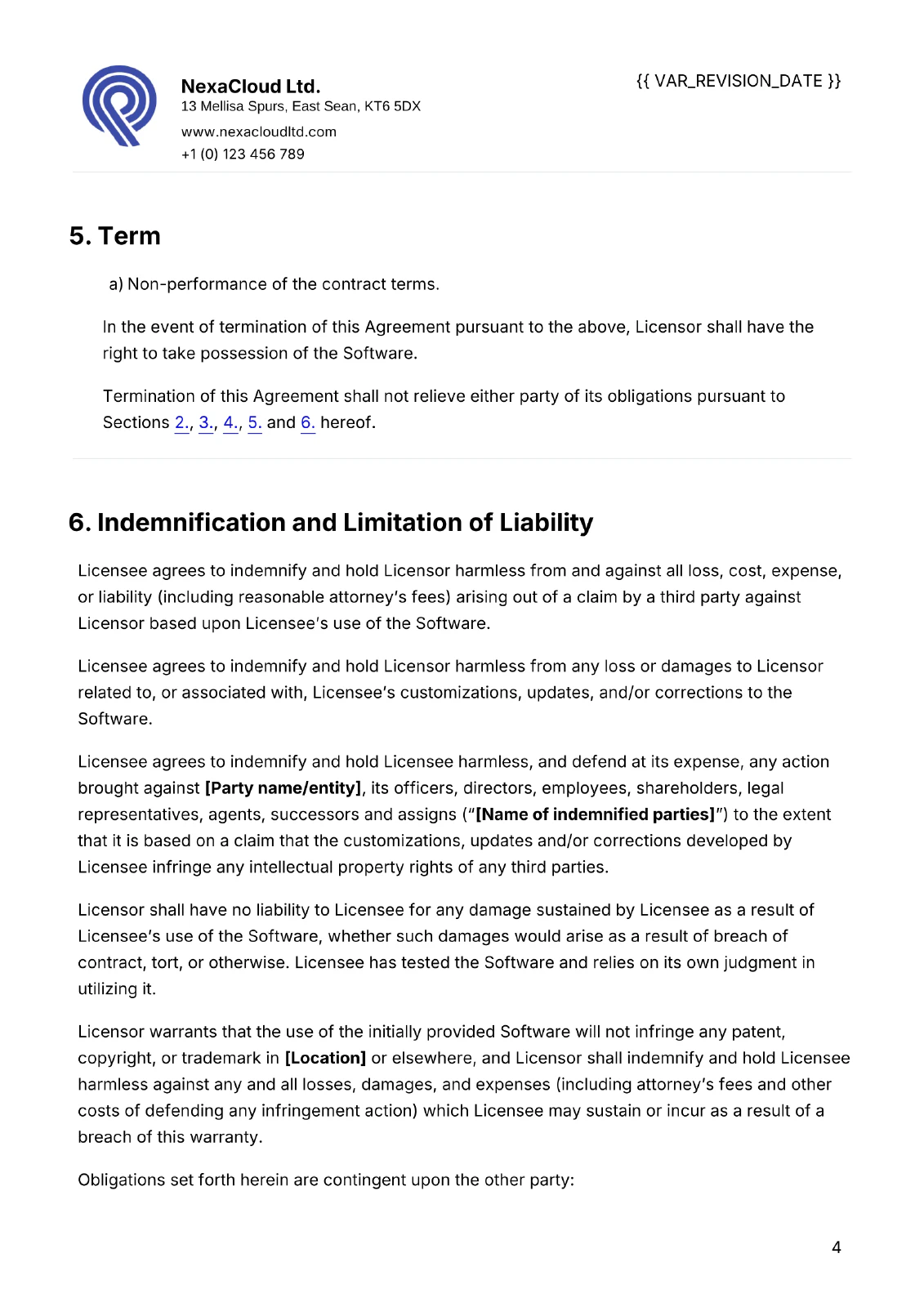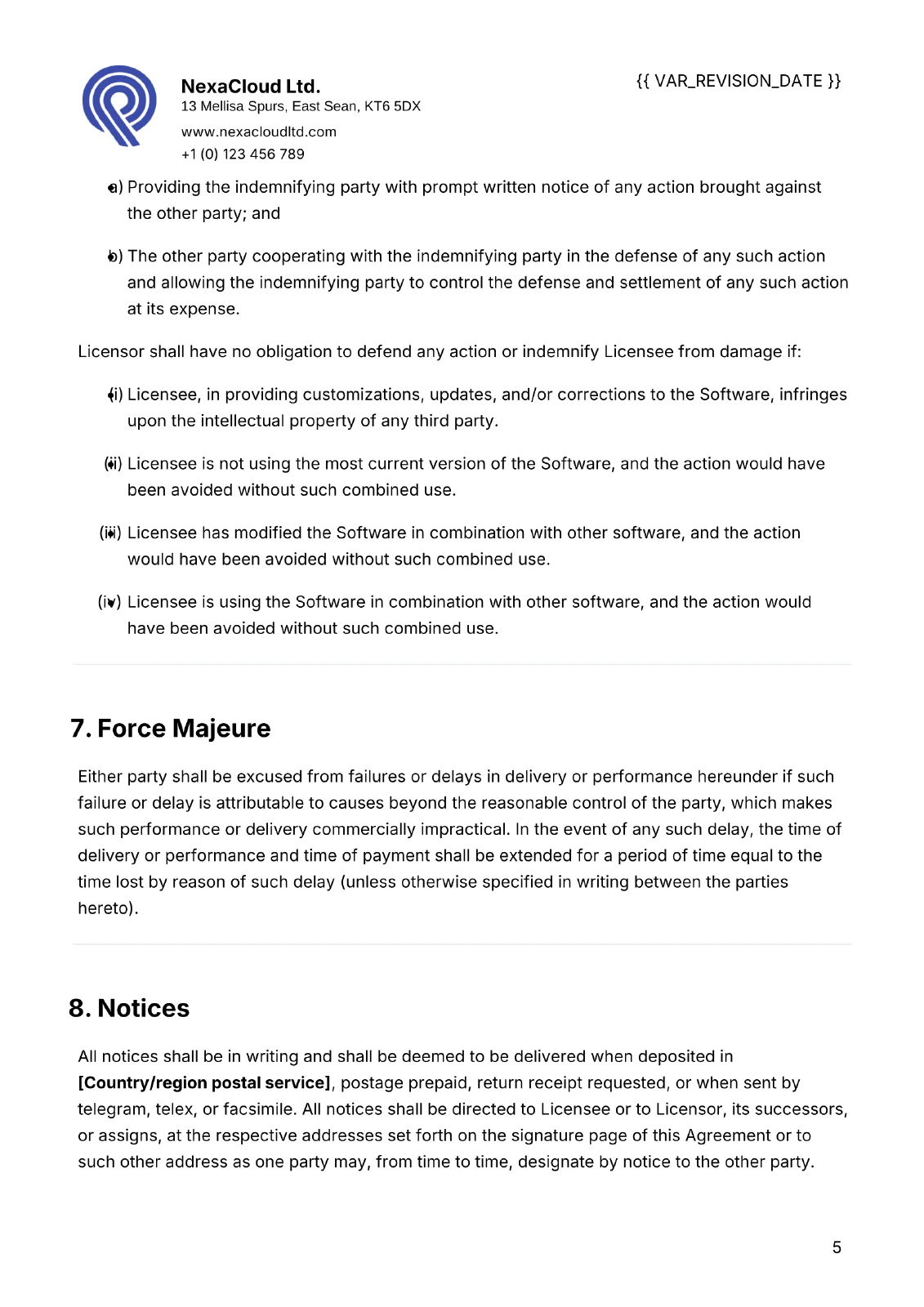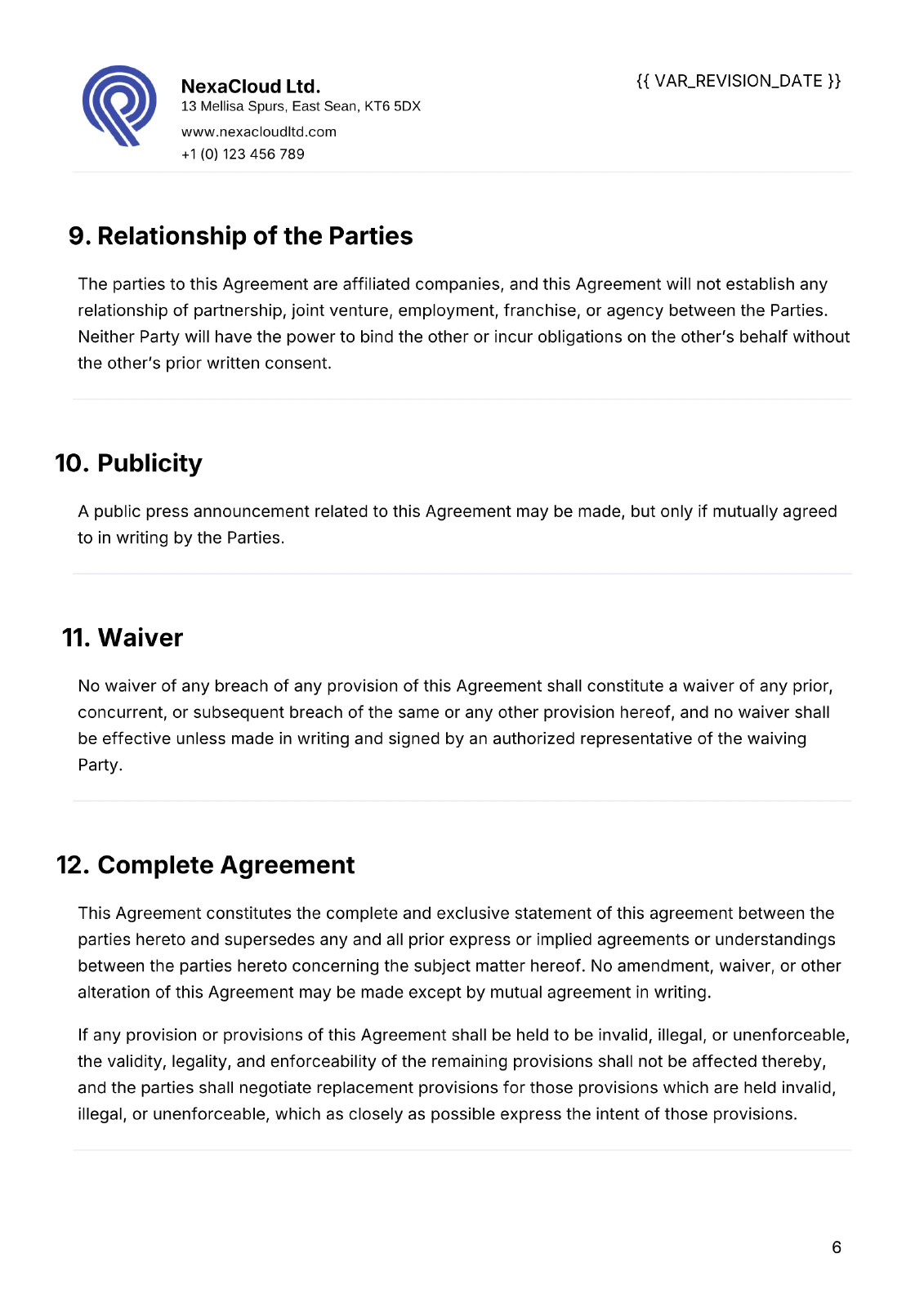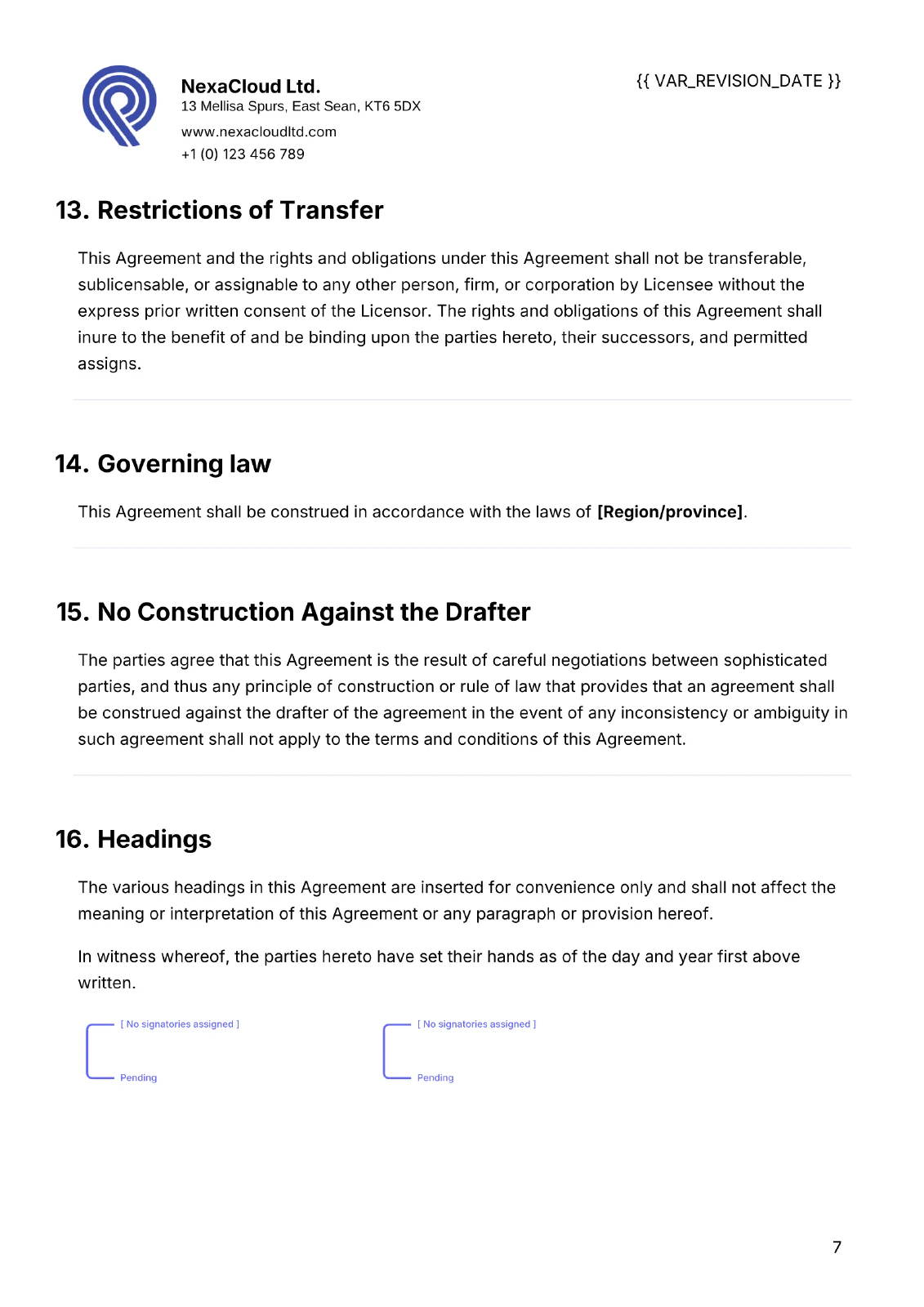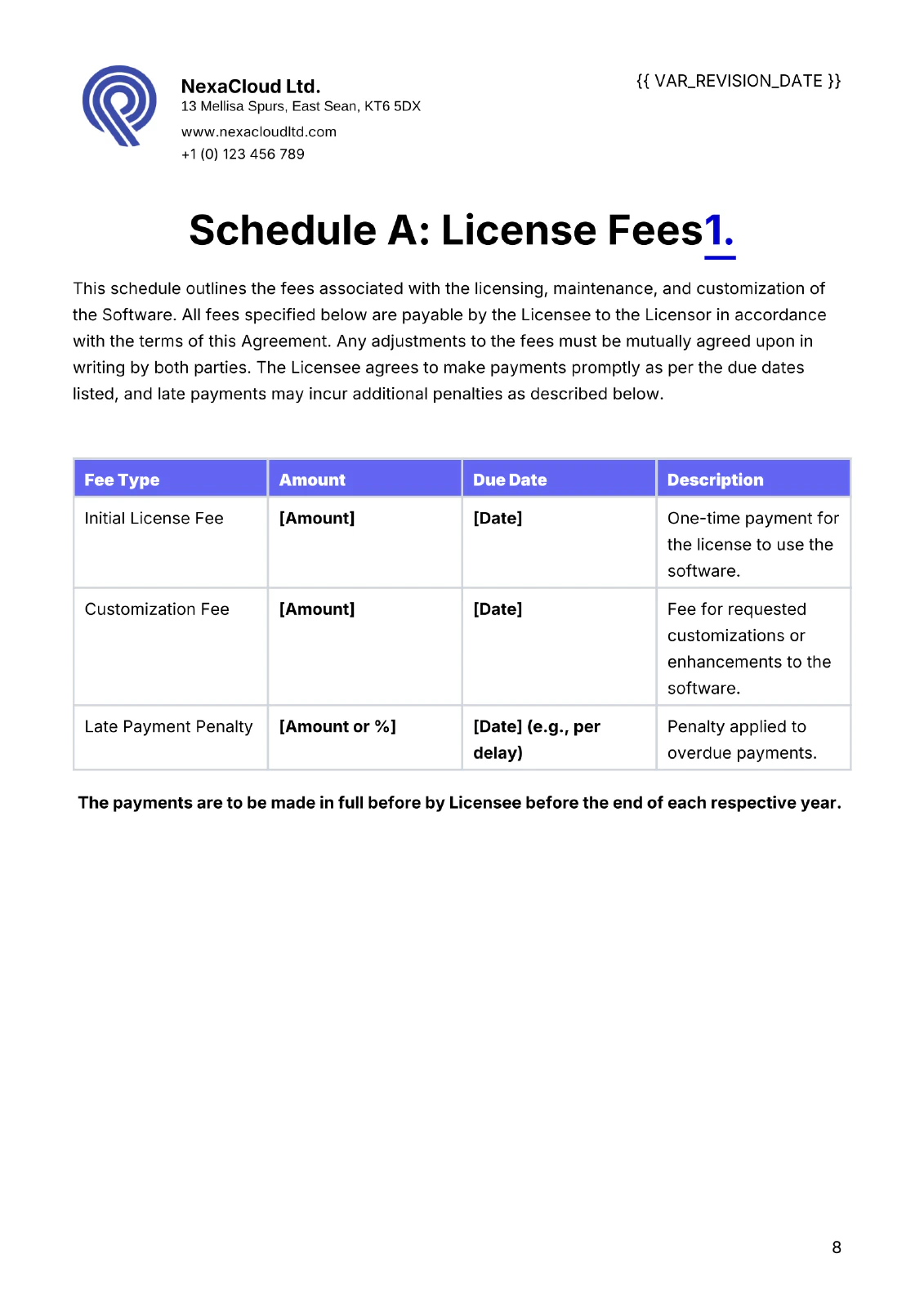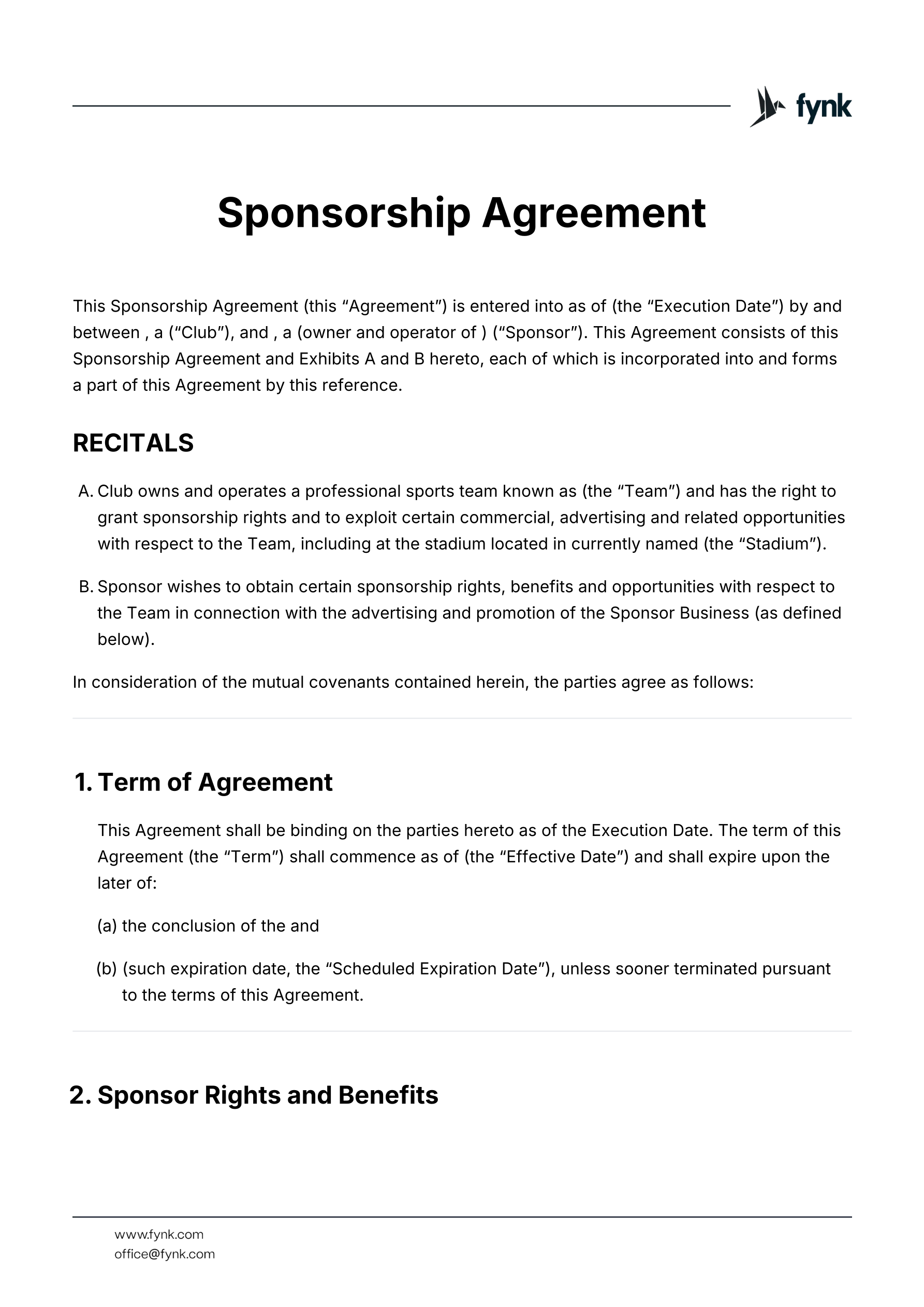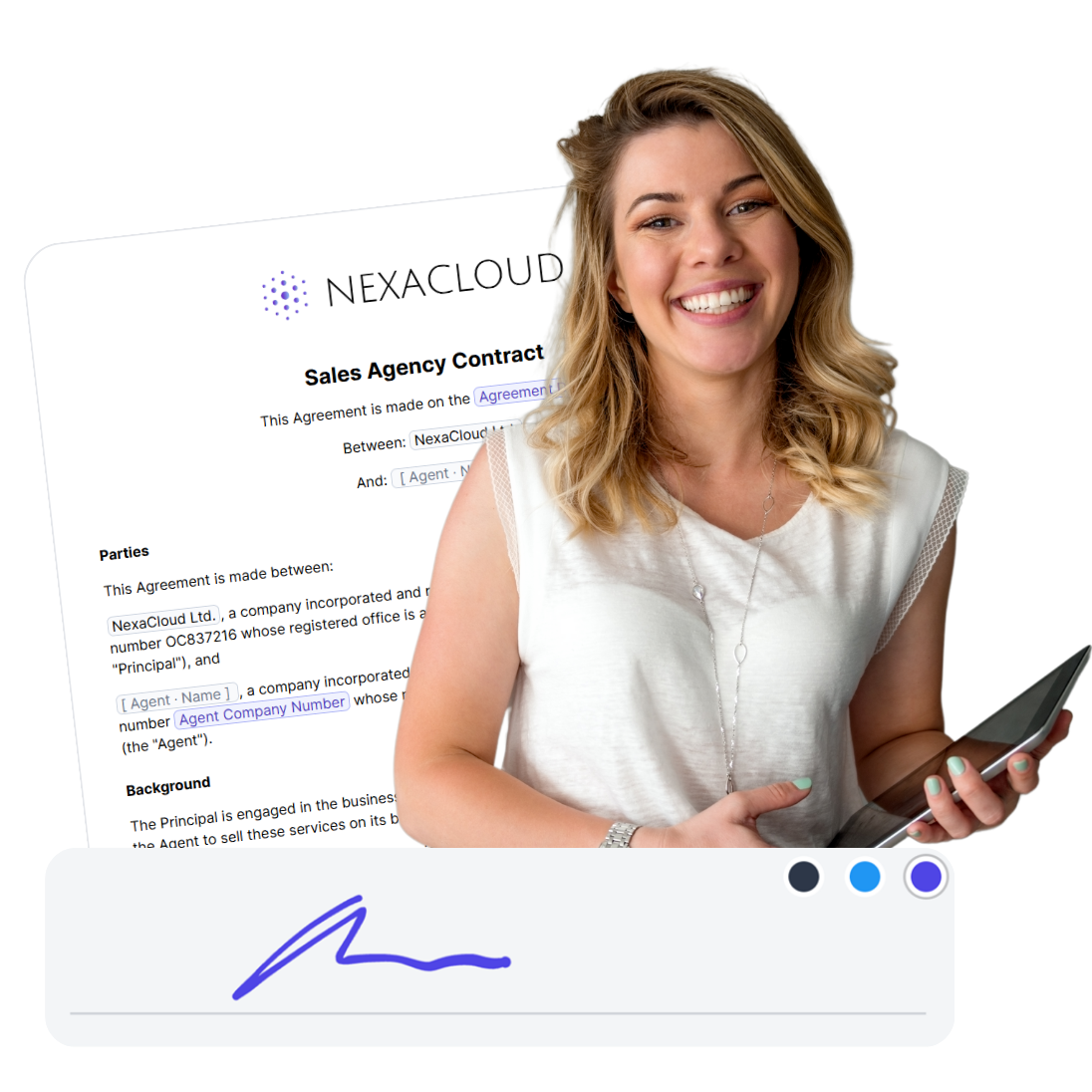SOFTWARE LICENSE AGREEMENT
This Software License Agreement (Agreement) is entered into this [Effective date] between , a [Location, region] company, with offices at (Licensor), and , a [Location, region] company, with offices at (Licensee).
WHEREAS, Licensor owns the [Software name] (Software); and
WHEREAS, Licensee is desirous of Licensor developing Software for Licensee’s non-exclusive use; to utilize such Software, and to make customizations, updates, and/or corrections; and
WHEREAS, for the good and valuable consideration, the receipt of which is hereby acknowledged, Licensor is willing to license the Software to Licensee; and
WHEREAS, Licensee is willing to accept the Software license under the conditions set forth set forth above.
NOW, THEREFORE the parties agree as follows:
License Granted
Subject to the terms and conditions of this Agreement and in consideration of Licensee’s obligation to pay monetary fees as outlined in Schedule A, such fees which may be adjusted from time to time by mutual written consent of the parties, Licensor hereby grants, and Licensee hereby accepts, a worldwide, non-exclusive, non-transferable, irrevocable, perpetual right and licence, to use the Software and all related documentation for use in [Relevant field] mobile apps.
Licensor also grants permission to Licensee to make and create customizations, updates, or corrections to the Software. The parties agree that Licensor shall continue to own all right, title, and interest in and to the Software and all intellectual property rights embodied therein or related thereto including, but not limited to, the source and object codes and any customizations, updates, and corrections to the Software. Except as expressly provided herein, no intellectual property rights are granted to Licensee by implication, estoppel, or otherwise.
Licensee will safeguard the Software and its related materials with that degree of normal due care commensurate with reasonable standards of industrial security for the protection of trade secrets and proprietary information so that no unauthorized use is made of them and no disclosure of any part of their contents is made to anyone other than Licensee’s employees, agents, or consultants whose duties reasonably require such disclosure, or as necessary in the ordinary course of business. Licensee shall make all such persons fully aware of their responsibility to fulfill the obligations of Licensee under this Agreement.
Software Provided “as is”
Licensor warrants that it has the right to provide the Software to Licensee hereunder. Otherwise, Licensor provides the Software to Licensee “as is.” Licensor makes no warranties or representations that the Software is free of errors or defects, or that it adequately performs the functions it is intended to perform. Licensee shall test the Software to ensure its acceptability for Licensee’s purpose prior to putting the Software in productive use.
Licensor is under no obligation to update or correct defects or errors in the Software. If Licensor does provide Licensee with updates or corrections, the terms and conditions of this Agreement shall apply.
Warranties of Licensee
Related to customizations, updates, and/or corrections of Licensee to the Software, Licensee represents and warrants that:
Licensee has all intellectual property rights necessary to produce customizations, updates, and/or corrections to the Software;
Licensee does not infringe the intellectual property rights of any third party;
Licensee will make any customizations or enhancements to the Software under this Agreement in accordance with industry standards and in a professional and workmanlike fashion;
Following completion of any customizations or enhancements to the Software, such will remain free from material programming errors and defects in workmanship and materials and will substantially conform to the specifications and any related documentation for [Number] days (“Warranty Period”). If material programming errors are discovered during the Warranty Period, Licensee shall promptly remedy such errors at no additional expense to Licensor.
Property Rights and Restrictions on Use
Licensee recognizes that the Software, and customizations, updates, or corrections, if any, are the property of, and all rights thereto, are owned by Licensor. Licensee also acknowledges that such are a trade secret of Licensor, are valuable and confidential to Licensor, and that its use and disclosure must be carefully and continuously controlled.
Title to the Software, and customizations, updates, or corrections, if any, shall at all times remain with Licensor.
Licensee shall keep the Software, and customizations, updates, and/or corrections, if any, free and clear of any claims, liens, and encumbrances attributable to the use or possession of the Software by Licensee. Any act of Licensee, whether voluntarily or involuntarily, purporting to create a claim of encumbrance shall be void.
The Software is for the sole use of Licensee and shall be used only for the purpose set forth in this Agreement.
Licensee shall treat the Software, and customizations, updates, and/or corrections, if any, as confidential and proprietary, and shall protect it in the same manner that it protects the confidentiality of its own information. While this Agreement is in effect, or while Licensee has custody and possession of the Software, Licensee will not:
Provide or make available the Software to any person or entity other than employees of Licensee who have a need to know consistent with Licensee’s use thereof under this Agreement; or
Create or attempt to create, or permit others to create or attempt to create, by disassembling, reverse engineering, or otherwise, the source program or any part thereof from the object program or other information made available to Licensee pursuant to this Agreement.
Licensee agrees to promptly notify Licensor if it obtains information as to any unauthorized possession, use, or disclosure of the Software by any person or entity, and further agrees to cooperate with Licensor in protecting Licensor’s proprietary rights.
If Licensee, its officers, agents, or employees breach any provision of this Agreement, such breach must be cured within [Number] days of receipt of Licensor’s written notice describing such breach. If such breach is not cured within the [Number] days after receipt of the notice, Licensee shall pay Licensor reasonable monetary payments for loss and/or damages related to such breach.
Term
Non-performance of the contract terms.
In the event of termination of this Agreement pursuant to the above, Licensor shall have the right to take possession of the Software.
Termination of this Agreement shall not relieve either party of its obligations pursuant to Sections 2., 3., 4., 5. and 6. hereof.
Indemnification and Limitation of Liability
Licensee agrees to indemnify and hold Licensor harmless from and against all loss, cost, expense, or liability (including reasonable attorney’s fees) arising out of a claim by a third party against Licensor based upon Licensee’s use of the Software.
Licensee agrees to indemnify and hold Licensor harmless from any loss or damages to Licensor related to, or associated with, Licensee’s customizations, updates, and/or corrections to the Software.
Licensee agrees to indemnify and hold Licensee harmless, and defend at its expense, any action brought against [Party name/entity], its officers, directors, employees, shareholders, legal representatives, agents, successors and assigns (“[Name of indemnified parties]”) to the extent that it is based on a claim that the customizations, updates and/or corrections developed by Licensee infringe any intellectual property rights of any third parties.
Licensor shall have no liability to Licensee for any damage sustained by Licensee as a result of Licensee’s use of the Software, whether such damages would arise as a result of breach of contract, tort, or otherwise. Licensee has tested the Software and relies on its own judgment in utilizing it.
Licensor warrants that the use of the initially provided Software will not infringe any patent, copyright, or trademark in [Location] or elsewhere, and Licensor shall indemnify and hold Licensee harmless against any and all losses, damages, and expenses (including attorney’s fees and other costs of defending any infringement action) which Licensee may sustain or incur as a result of a breach of this warranty.
Obligations set forth herein are contingent upon the other party:
Providing the indemnifying party with prompt written notice of any action brought against the other party; and
The other party cooperating with the indemnifying party in the defense of any such action and allowing the indemnifying party to control the defense and settlement of any such action at its expense.
Licensor shall have no obligation to defend any action or indemnify Licensee from damage if:
Licensee, in providing customizations, updates, and/or corrections to the Software, infringes upon the intellectual property of any third party.
Licensee is not using the most current version of the Software, and the action would have been avoided without such combined use.
Licensee has modified the Software in combination with other software, and the action would have been avoided without such combined use.
Licensee is using the Software in combination with other software, and the action would have been avoided without such combined use.
Force Majeure
Either party shall be excused from failures or delays in delivery or performance hereunder if such failure or delay is attributable to causes beyond the reasonable control of the party, which makes such performance or delivery commercially impractical. In the event of any such delay, the time of delivery or performance and time of payment shall be extended for a period of time equal to the time lost by reason of such delay (unless otherwise specified in writing between the parties hereto).
Notices
All notices shall be in writing and shall be deemed to be delivered when deposited in [Country/region postal service], postage prepaid, return receipt requested, or when sent by telegram, telex, or facsimile. All notices shall be directed to Licensee or to Licensor, its successors, or assigns, at the respective addresses set forth on the signature page of this Agreement or to such other address as one party may, from time to time, designate by notice to the other party.
Relationship of the Parties
The parties to this Agreement are affiliated companies, and this Agreement will not establish any relationship of partnership, joint venture, employment, franchise, or agency between the Parties. Neither Party will have the power to bind the other or incur obligations on the other’s behalf without the other’s prior written consent.
Publicity
A public press announcement related to this Agreement may be made, but only if mutually agreed to in writing by the Parties.
Waiver
No waiver of any breach of any provision of this Agreement shall constitute a waiver of any prior, concurrent, or subsequent breach of the same or any other provision hereof, and no waiver shall be effective unless made in writing and signed by an authorized representative of the waiving Party.
Complete Agreement
This Agreement constitutes the complete and exclusive statement of this agreement between the parties hereto and supersedes any and all prior express or implied agreements or understandings between the parties hereto concerning the subject matter hereof. No amendment, waiver, or other alteration of this Agreement may be made except by mutual agreement in writing.
If any provision or provisions of this Agreement shall be held to be invalid, illegal, or unenforceable, the validity, legality, and enforceability of the remaining provisions shall not be affected thereby, and the parties shall negotiate replacement provisions for those provisions which are held invalid, illegal, or unenforceable, which as closely as possible express the intent of those provisions.
Restrictions of Transfer
This Agreement and the rights and obligations under this Agreement shall not be transferable, sublicensable, or assignable to any other person, firm, or corporation by Licensee without the express prior written consent of the Licensor. The rights and obligations of this Agreement shall inure to the benefit of and be binding upon the parties hereto, their successors, and permitted assigns.
Governing law
This Agreement shall be construed in accordance with the laws of [Region/province].
No Construction Against the Drafter
The parties agree that this Agreement is the result of careful negotiations between sophisticated parties, and thus any principle of construction or rule of law that provides that an agreement shall be construed against the drafter of the agreement in the event of any inconsistency or ambiguity in such agreement shall not apply to the terms and conditions of this Agreement.
Headings
The various headings in this Agreement are inserted for convenience only and shall not affect the meaning or interpretation of this Agreement or any paragraph or provision hereof.
In witness whereof, the parties hereto have set their hands as of the day and year first above written.
Schedule A: License Fees1.
This schedule outlines the fees associated with the licensing, maintenance, and customization of the Software. All fees specified below are payable by the Licensee to the Licensor in accordance with the terms of this Agreement. Any adjustments to the fees must be mutually agreed upon in writing by both parties. The Licensee agrees to make payments promptly as per the due dates listed, and late payments may incur additional penalties as described below.
Fee Type | Amount | Due Date | Description |
|---|---|---|---|
Initial License Fee | [Amount] | [Date] | One-time payment for the license to use the software. |
Customization Fee | [Amount] | [Date] | Fee for requested customizations or enhancements to the software. |
Late Payment Penalty | [Amount or %] | [Date] (e.g., per delay) | Penalty applied to overdue payments. |
The payments are to be made in full before by Licensee before the end of each respective year.

